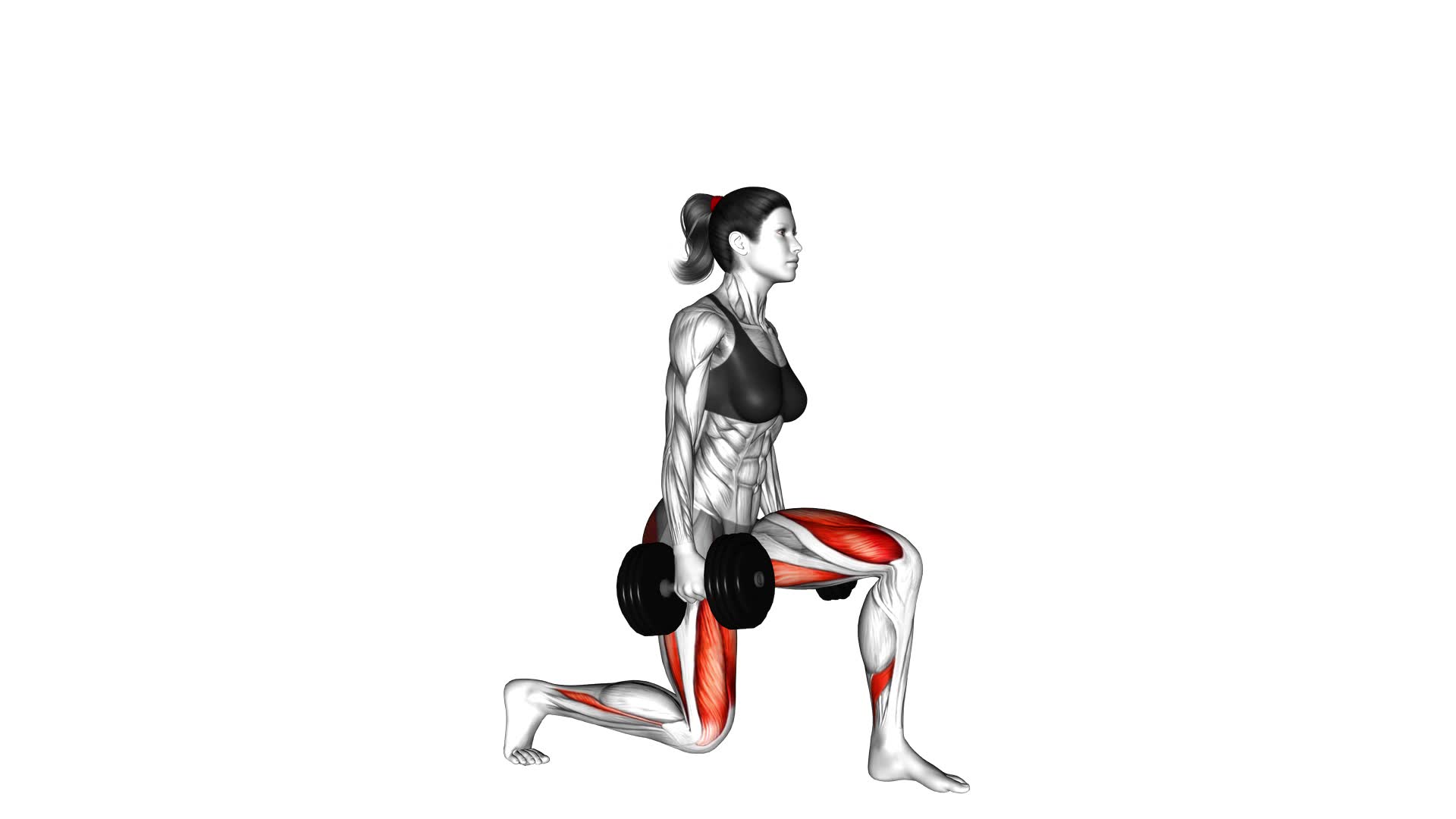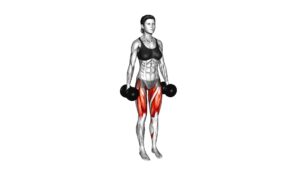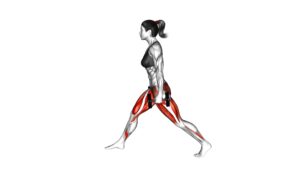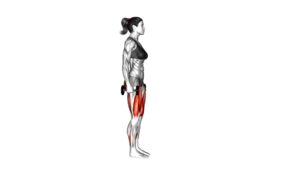Dumbbell Lunge (female) – Video Exercise Guide & Tips

Looking to tone your legs and build strength? The dumbbell lunge is the exercise for you! In this video exercise guide, we'll show you the proper form and technique for performing dumbbell lunges.
Watch This Exercise Video
With variations and progression options, you can challenge yourself and continue to see progress. Avoid common mistakes and maximize your results with our expert tips.
Get ready to feel the burn and achieve your fitness goals with this effective exercise. Let's get started!
Key Takeaways
- Dumbbell lunges strengthen multiple muscle groups at once, targeting the quadriceps, hamstrings, and glutes.
- Engaging the core muscles during dumbbell lunges improves stability and balance.
- Incorporating variations like forward, reverse, and lateral lunges adds variety and challenges the muscles.
- To maximize results, it is important to maintain proper form and technique, avoid common mistakes, and gradually increase weight and repetitions.
Benefits of Dumbbell Lunges
One of the benefits of dumbbell lunges is that they help you strengthen multiple muscle groups at once. This exercise is highly effective in targeting the muscles of your legs, including your quadriceps, hamstrings, and glutes. Additionally, dumbbell lunges also engage your core muscles, helping to improve stability and balance.
To maximize the benefits of dumbbell lunges, you can incorporate different variations into your workout routine. One variation is the forward lunge, where you step forward with one leg and lower your body until both knees are at 90-degree angles. Another variation is the reverse lunge, where you step backward with one leg and lower your body in the same manner. You can also try lateral lunges, where you step to the side and lower your body, targeting your inner and outer thighs.
To incorporate dumbbell lunges into your workout routine, start by choosing an appropriate weight dumbbell that challenges you but allows you to maintain proper form. Begin with a warm-up, such as jogging or jumping jacks, to prepare your muscles. Then, perform 2-3 sets of 10-12 repetitions on each leg, resting for 30-60 seconds between sets. As you become more comfortable and stronger, you can increase the weight and repetitions to continue challenging your muscles.
Proper Form and Technique
To perform dumbbell lunges with proper form and technique, you need to focus on your body alignment and movement. Start by standing tall with your feet hip-width apart. Hold a dumbbell in each hand, letting your arms hang by your sides.
Take a step forward with your right foot, keeping your torso upright and shoulders back. As you descend into the lunge, make sure your front knee tracks over your toes and your back knee hovers just above the ground. Your weight should be evenly distributed between both legs.
Engage your core and maintain a neutral spine throughout the movement. To improve balance, engage your glutes and quads to stabilize your body. Focus on muscle activation by pushing through your front heel to stand back up to the starting position and repeat on the other side.
By performing dumbbell lunges with proper form and technique, you'll effectively target your lower body muscles while improving balance and stability.
Now, let's explore some variations and progressions to take your lunges to the next level.
Variation and Progression
To further challenge yourself and continue improving, incorporate variations and progressions into your dumbbell lunges routine. Here are some dumbbell lunge variations and advanced lunge progressions that you can try:
- Dumbbell Walking Lunges: Instead of staying in one spot, take a step forward with each lunge, alternating legs as you go. This adds an element of balance and stability to the exercise.
- Dumbbell Reverse Lunges: Start by stepping backward with one leg instead of forward. This variation targets your glutes and hamstrings in a slightly different way.
- Jumping Lunges: Add some plyometric power to your lunges by jumping and switching legs mid-air. This explosive movement increases the intensity and engages your fast-twitch muscle fibers.
- Bulgarian Split Squats: Elevate your back foot on a bench or step, and perform the lunge with one leg at a time. This variation places more emphasis on your quads and challenges your balance.
By incorporating these dumbbell lunge variations and advanced lunge progressions, you can keep your workouts fresh and continue challenging your muscles.
Now, let's move on to the next section and discuss some common mistakes to avoid.
Common Mistakes to Avoid
To ensure proper form and maximize the effectiveness of your dumbbell lunges, it's important to be aware of common mistakes to avoid.
One common mistake isn't maintaining proper technique throughout the exercise. It's crucial to keep your back straight and your core engaged to avoid putting unnecessary strain on your lower back.
Another mistake to avoid isn't stepping far enough forward during the lunge. This can lead to improper alignment and reduce the effectiveness of the exercise.
Additionally, it's important to avoid letting your knees go past your toes when lowering into the lunge position. This can place excessive stress on the knee joint and increase the risk of injury.
Lastly, remember to avoid rushing through the exercise and sacrificing proper form for speed. Take your time and focus on each repetition to ensure maximum benefit.
By avoiding these common mistakes, you can perform dumbbell lunges with proper technique and maximize your results.
Now, let's move on to the next section and learn some tips for maximizing your results.
Tips for Maximizing Results
To maximize your results, incorporate a variety of dumbbell lunge variations into your workout routine. Dumbbell lunges are a highly effective exercise that target multiple muscle groups, making them a great addition to a full body workout. Here are some tips on how to incorporate dumbbell lunges into a full body workout and modify them for beginners:
- Incorporating dumbbell lunges into a full body workout:
- Start with a warm-up: Begin your workout with 5-10 minutes of light cardio to get your muscles warm and ready.
- Alternate upper and lower body exercises: After completing a set of dumbbell lunges, follow it up with an upper body exercise such as dumbbell presses or push-ups. This helps keep your heart rate up and maximizes calorie burn.
- Modifying dumbbell lunges for beginners:
- Start with bodyweight lunges: If you're new to dumbbell lunges, begin by performing them without weights. Focus on maintaining proper form and gradually increase the difficulty by adding weights.
- Use lighter dumbbells: Instead of using heavy dumbbells, start with lighter weights to build strength and improve your form. As you progress, you can gradually increase the weight.
Frequently Asked Questions
How Heavy Should the Dumbbells Be for a Female Beginner Attempting Dumbbell Lunges?
For a female beginner attempting dumbbell lunges, it's important to start with lighter weights to ensure proper form and prevent injury. Begin with dumbbells that feel comfortable and manageable, around 5-10 pounds.
As you become more comfortable and stronger, gradually increase the weight. Dumbbell lunges are a great exercise for targeting multiple muscle groups and improving overall fitness.
They can be done with various variations to challenge different areas of your body and increase strength and stability.
Can Dumbbell Lunges Help in Reducing Cellulite?
Dumbbell lunges are a great exercise for toning your thighs and can be helpful for weight loss. They target multiple muscle groups, including the glutes, quadriceps, and hamstrings, which can help to reduce cellulite and improve overall leg strength.
Are There Any Modifications or Alternatives for Individuals With Knee Pain or Injuries?
If you're dealing with knee pain or injuries, there are modifications and alternatives you can try for dumbbell lunges. It's important to listen to your body and not push through any pain.
Instead of lunging forward, you can try lunging backward or to the side, which can put less strain on the knees. Another option is to use a lighter weight or no weight at all and focus on proper form and control.
Remember to consult with a healthcare professional before making any changes to your exercise routine.
How Many Sets and Repetitions Should Be Performed for Optimal Results?
To achieve optimal results in dumbbell lunges, it's important to consider how to progress in this exercise. Start by performing 2-3 sets of 8-12 repetitions with a weight that challenges you, but still allows for proper form.
As you become stronger, gradually increase the weight or repetitions to continue progressing. Dumbbell lunges are beneficial for overall strength and stability, targeting multiple muscle groups in the lower body.
Incorporating them into your routine can help improve balance and coordination.
Is It Necessary to Warm up Before Performing Dumbbell Lunges?
Yes, it's necessary to warm up before performing dumbbell lunges.
Incorporating dumbbell lunges into your workout routine offers numerous benefits, such as improved lower body strength and stability.
To ensure optimal results, it's important to maintain proper form and technique while performing the exercise.
Warming up before starting your workout helps prepare your muscles and joints, reducing the risk of injury and allowing you to perform the exercise more effectively.
Conclusion
In conclusion, incorporating dumbbell lunges into your workout routine can provide numerous benefits, such as improved leg strength, balance, and overall lower body stability.
By maintaining proper form and technique, you can maximize the effectiveness of this exercise and avoid common mistakes.
Additionally, varying the intensity and progression of the dumbbell lunges can further challenge your muscles and help you achieve your fitness goals.
Remember to consult with a fitness professional for individualized guidance and to ensure safe and effective execution.

Author
Years ago, the spark of my life’s passion ignited in my mind the moment I stepped into the local gym for the first time. The inaugural bead of perspiration, the initial endeavor, the very first surge of endorphins, and a sense of pride that washed over me post-workout marked the beginning of my deep-seated interest in strength sports, fitness, and sports nutrition. This very curiosity blossomed rapidly into a profound fascination, propelling me to earn a Master’s degree in Physical Education from the Academy of Physical Education in Krakow, followed by a Sports Manager diploma from the Jagiellonian University. My journey of growth led me to gain more specialized qualifications, such as being a certified personal trainer with a focus on sports dietetics, a lifeguard, and an instructor for wellness and corrective gymnastics. Theoretical knowledge paired seamlessly with practical experience, reinforcing my belief that the transformation of individuals under my guidance was also a reflection of my personal growth. This belief holds true even today. Each day, I strive to push the boundaries and explore new realms. These realms gently elevate me to greater heights. The unique combination of passion for my field and the continuous quest for growth fuels my drive to break new ground.



